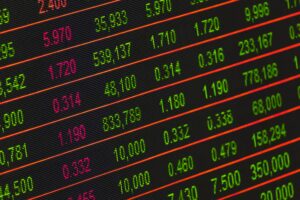Inflation is the rate at which the general level of  prices for goods and services is rising and subsequently purchasing power is falling. Central banks attempt to limit inflation and avoid deflation, in order to keep the economy running smoothly.
prices for goods and services is rising and subsequently purchasing power is falling. Central banks attempt to limit inflation and avoid deflation, in order to keep the economy running smoothly.
It is not one international institution such as The United Nations (UN) that has a specific mechanism for controlling inflation on an international level. However, the UN does have agencies, such as the International Monetary Fund (IMF) and the World Bank, that work with member countries to promote economic stability and growth, which can help to mitigate inflation. Additionally, the UN may make recommendations or provide assistance to member countries experiencing high inflation through its various economic and social development programs.
Central banks use a variety of tools to control inflation. The most common methods include setting interest rates. Central banks can raise interest rates to make borrowing more expensive, which can slow down economic growth and reduce inflationary pressures.
Further, central banks can buy or sell government securities to control the money supply and influence interest rates. They too can change the number of reserves that commercial banks are required to hold, which can affect the amount of money that banks have available to lend.
In addition, central banks can communicate their future policy actions, to help shape expectations and influence the behaviour of consumers, businesses, and investors. And the last method open to the central banks is to create new money and use it to buy financial assets such as government bonds, lower long-term interest rates and increase the money supply otherwise known as Quantitative Easing.
Each central bank has its own monetary policy, which is the set of tools they use to achieve its goals, such as controlling inflation, stabilizing the currency, and promoting economic growth.
Central banks do not necessarily coordinate their interest rate decisions with each other, as each country has its own unique economic conditions and policy goals. However, they may take into account the monetary policy actions of other major central banks when making their own decisions. For example, if the Federal Reserve (the central bank of the United States) raises interest rates, it could put upward pressure on interest rates in other countries, and other central banks may take that into account when deciding on their own interest rate policy. Additionally, central banks may coordinate their actions during times of financial crisis to provide liquidity and stability to the global financial system.
take into account the monetary policy actions of other major central banks when making their own decisions. For example, if the Federal Reserve (the central bank of the United States) raises interest rates, it could put upward pressure on interest rates in other countries, and other central banks may take that into account when deciding on their own interest rate policy. Additionally, central banks may coordinate their actions during times of financial crisis to provide liquidity and stability to the global financial system.
The use of central banks to control inflation and stabilize the economy is a relatively modern development. The concept of a central bank can be traced back to the late 17th century, with the establishment of the Bank of Sweden in 1668, but the modern central banking system as we know it today has been in place for over a century. The Federal Reserve System, the central bank of the United States, was established in 1913 and since then many other countries have followed suit and established their own central banks.
The use of monetary policy tools such as setting interest rates and open market operations to control inflation and stabilize the economy also has a relatively short history. These tools were first developed in the 1930s and 1940s and have been refined and expanded over time.
It’s worth noting that different central banks use different monetary policy tools and they may have different policy objectives and frameworks, but overall the system has been in place for more than a century. The goal of central banks is generally to maintain low and stable inflation, but the target rate can vary depending on the country and the specific central bank. In some countries, the target rate is zero inflation, meaning that prices are stable and not rising. In other countries, the target rate is a low but positive rate of inflation, typically around 2%.
Achieving zero inflation can be difficult and may have negative  consequences for the economy. Zero inflation can lead to deflation, which is a sustained decrease in the general price level of goods and services. Deflation can lead to lower economic growth, as consumers and businesses may delay spending and invest in anticipation of lower prices in the future. Additionally, zero inflation can make it more difficult for central banks to stimulate economic growth by cutting interest rates, as interest rates cannot be negative.
consequences for the economy. Zero inflation can lead to deflation, which is a sustained decrease in the general price level of goods and services. Deflation can lead to lower economic growth, as consumers and businesses may delay spending and invest in anticipation of lower prices in the future. Additionally, zero inflation can make it more difficult for central banks to stimulate economic growth by cutting interest rates, as interest rates cannot be negative.
For these reasons, many central banks aim for a target rate of low but positive inflation, which allows for some flexibility in monetary policy and can help to avoid the negative consequences of deflation. One example of bad inflation in history is the hyperinflation that occurred in Germany in the early 1920s. After World War I, Germany was required to pay large reparations to the victorious Allied powers. To finance these payments, the German government printed large amounts of money, leading to a rapid increase in the money supply. This, coupled with other economic and political factors, led to a period of hyperinflation in which prices for goods and services increased at an extremely rapid pace. At its worst, prices were doubling every few days, and the German currency, the mark, became practically worthless. People would carry wheelbarrows of money to buy basic goods, and salaries were paid multiple times a day to keep up with the inflation. This period of hyperinflation had a devastating effect on the German economy and society, leading to widespread poverty, unemployment, and social unrest. It also contributed to the rise of the Nazi party and the eventual collapse of the Weimar Republic.
Hyperinflation is an extreme example of bad inflation, it’s a rare but severe form of inflation that can have a destructive effect on an economy and society. It can be caused by a variety of factors such as war, political instability, or monetary mismanagement.
Inflation was not a major factor in the stock market crash of 1929 and the subsequent Great Depression in the United States. The crash was primarily caused by a combination of factors, including speculative excesses in the stock market, a lack of regulation in the financial sector, and underlying structural issues in the economy.
Before the crash, the economy was booming, driven by new technologies, increased productivity, and a rising stock market. However, many stocks were overvalued and there were widespread speculative activities in the market. When the market began to decline in late 1929, many investors panicked and began selling, leading to a downward spiral in stock prices.
The depression was exacerbated by a number of factors, including the collapse of the banking system and the contraction of credit, along with the failure of policies and institutions that were supposed to provide stability. The Federal Reserve, the central bank of the United States, was criticized for not doing enough to stem the crisis and for allowing the money supply to shrink.
contraction of credit, along with the failure of policies and institutions that were supposed to provide stability. The Federal Reserve, the central bank of the United States, was criticized for not doing enough to stem the crisis and for allowing the money supply to shrink.
Inflation was not a major problem during the Great Depression, on the contrary, the economy was characterized by deflation, a sustained decrease in the general price level of goods and services. Due to the contraction of the money supply, decrease in demand and decrease in production, prices dropped significantly, making it harder for the economy to recover and for individuals to pay off their debts.
Deflation is a sustained decrease in the general price level of goods and services. This means that the purchasing power of money increases, as the same amount of money can buy more goods and services than before. Deflation can occur when there is a decrease in the money supply, a decrease in demand for goods and services, or an increase in production.
Deflation can be harmful to an economy, as it can lead to lower economic growth and higher unemployment. When prices are falling, consumers and businesses may delay spending and invest in anticipation of lower prices in the future. This can lead to a decrease in demand, which can cause businesses to cut back on production and lay off workers. As unemployment increases, consumer spending decreases, creating a vicious cycle of decreasing demand, production and employment.
Additionally, deflation can make it more difficult for central banks to stimulate economic growth by cutting interest rates, as interest rates cannot be negative. It can also make it harder for individuals and businesses to pay off their debts, as the value of the debt increases as prices fall.
In summary, deflation is the opposite of inflation, it is a sustained decrease in the general price level of goods and services and can have negative effects on an economy, such as lower economic growth and higher unemployment.
One historical example of deflation is the Great Depression of the 1930s. The Great Depression was a severe economic downturn that began in 1929 and lasted for more than a decade. A decline in economic activity, high unemployment, and a decrease in the general price level of goods and services characterised it.
During the Great Depression, the money supply contracted and demand for goods and services decreased, leading to a decrease in prices. This deflation made it harder for individuals and businesses to pay off their debts, as the value of their debt increased as prices fell. Additionally, as prices fell, businesses cut back on production and laid off workers, leading to high unemployment.
 The deflation of the Great Depression was further exacerbated by the failure of policies and institutions that were supposed to provide stability, such as the Federal Reserve, the central bank of the United States, which was criticized for not doing enough to stem the crisis and for allowing the money supply to shrink.
The deflation of the Great Depression was further exacerbated by the failure of policies and institutions that were supposed to provide stability, such as the Federal Reserve, the central bank of the United States, which was criticized for not doing enough to stem the crisis and for allowing the money supply to shrink.
The Great Depression was a global phenomenon and many other countries experienced deflation and economic decline as well, leading to a severe contraction of global trade and a decline in living standards.
It is considered one of the worst economic depressions in history, with a severe and long-lasting impact on the economy and society of many countries.
The Great Depression was eventually brought to an end by a combination of government policies and the onset of World War II.
One of the key policy responses to the Great Depression was the implementation of massive government spending programs, such as the New Deal in the United States. These programs put money into the hands of consumers and businesses, helping to boost demand and stimulate economic growth.
Additionally, governments around the world adopted expansionary monetary policies, such as increasing the money supply and lowering interest rates, to try to stimulate economic activity.
The onset of World War II also played a major role in ending the Great Depression. The massive government spending on the war effort led to a significant increase in economic activity, as businesses ramped up production to meet the needs of the military. The war also led to the employment of millions of people, which helped to decrease unemployment.
It’s worth noting that the recovery from the Great Depression was not immediate, it took time and some countries recovered faster than others. Additionally, not all the policies implemented were successful, some were even criticised for not being effective enough or for making the situation worse.
The Great Depression was a complex event with multiple causes and solutions, it serves as a reminder of the importance of economic stability and the need for effective policies to mitigate the effects of severe economic downturns.

